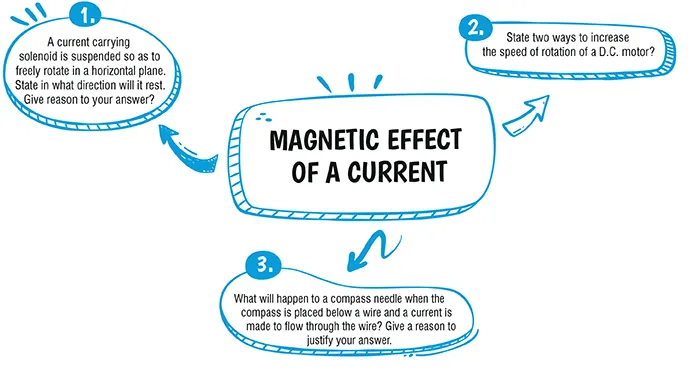Table of Contents


Ans. (b) Concentric circle
Explanation:
Magnetic field lines around a straight current carrying conductor are in the form of concentric circle.Magnetic field lines, also known as magnetic flux lines or magnetic lines of force, provide a visual representation of the magnetic field around a magnet or a current-carrying conductor. They offer a way to visualize the strength and direction of the magnetic field in space.
Ans. (a) North polarity
Explanation:
As per the clock rule, looking at the face of a loop, if the current around the face is in an anticlockwise direction then the face with have current in clockwise direction has the north polarity, while the face has the South polarity.
Explanation:
The current carrying solenoid when suspended freely, will rest along the N-S direction. The reason is that it will behave like a bar magnet, with N polarity at one face of solenoid and S polarity at the other face, depending upon the direction of current in the solenoid. Current carrying solenoid behaves like a bar magnet. At end in which direction of current is anticlockwise, behaves as north pole and where current is in clockwise direction behaves as south pole. Therefore on suspending the current carrying solenoid freely, it sets itself in N-S direction as bar magnet does.
Explanation:
Two ways to increase the speed of rotation of a D.C. motor are as follows:
(i) By increasing the strength of current in the coil.
(ii) By reducing the number of turns in the coil.
The speed of a DC motor is inversely proportional to the magnetic field's strength. By varying the current passing through the field winding (in case of wound field motors), the strength of the magnetic field and, hence, the speed of the motor can be controlled.
Explanation:
The compass needle will show deflection. This happens because when a current is passed through a conductor (here, wire), a magnetic field is produced around the conductor due to which the compass needle gets deflected.
Download Mind Map of this chapter
Download NowWant to Practice Mock Tests of this chapter
Practice NowDownload Important Questions of this chapter
Download Now| Chapter No. | Chapter Name |
|---|---|
| Chapter 1 | Force Work Power and Energy |
| Chapter 2 | Simple Machines |
| Chapter 3 | Refraction of Light |
| Chapter 4 | Refraction Through Lenses |
| Chapter 5 | Spectrum |
| Chapter 6 | Sound |
| Chapter 7 | Electricity |
| Chapter 8 | Electrical Power and Household Circuits |
| Chapter 11 | Magnetic Effect of Current |
| Chapter 12 | Specific Heat Capacity and Latent Heat |
| Chapter 13 | Radioactivity and Nuclear Energy |
| Chapter Wise Important Questions for ICSE Board Class 10 Physics |
|---|
| Force Work Power and Energy |
| Simple Machines |
| Refraction of Light |
| Refraction Through Lenses |
| Spectrum |
| Sound |
| Electricity |
| Electrical Power and Household Circuits |
| Magnetic Effect of Current |
| Specific Heat Capacity and Latent Heat |
| Radioactivity and Nuclear Energy |
CBSE Important Questions Class 10
ICSE Important Questions Class 10
CBSE Important Questions Class 10
ICSE Important Questions Class 10